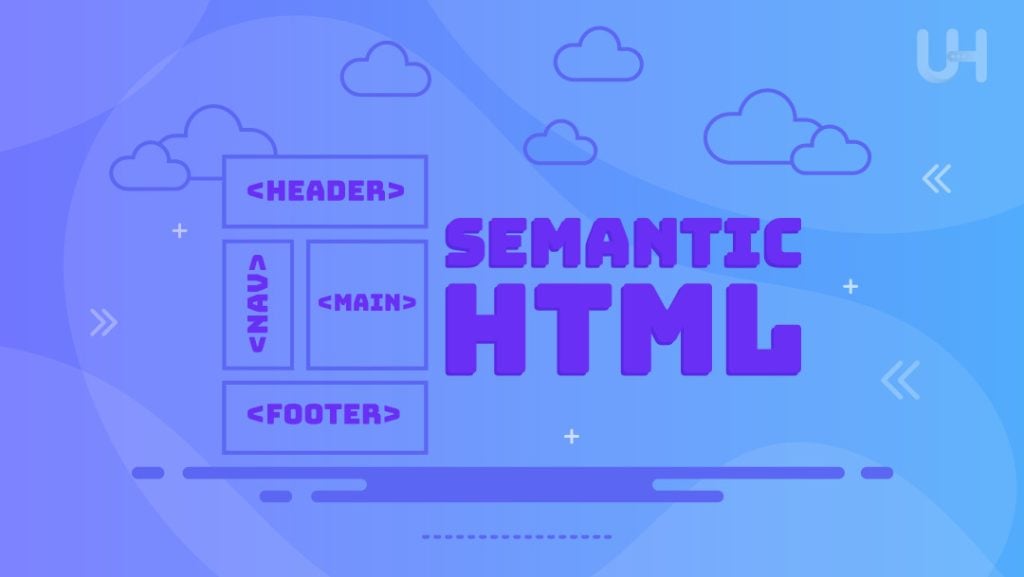
In web design, Semantic HTML tags are like special labels that give meaning to different parts of a webpage. They’re not just for looks – they help browsers and people understand what each part of a webpage is all about.
Think of it this way: if you use a <div> tag, it’s like saying, “Here’s a box,” without saying what’s inside. But if you use an <article> tag, it’s like saying, “Here’s a box, and inside is a whole story or article.” See the difference? The <article> tag gives more specific information about what’s inside the box.
These special tags are not only helpful for people browsing the web – they also make a big difference for search engines. Search engines use these tags to figure out what a webpage is talking about and how important different parts are. So, using tags like <header>, <nav>, <main>, <footer>, and <section> helps search engines understand your webpage better, which can make it show up higher in search results.
So, Semantic HTML isn’t just about making your webpage look nice – it’s about making it easy for everyone to understand, whether they’re using a screen reader, a search engine, or just browsing the web.
Importance of Semantic HTML
Semantic HTML, although often overlooked, plays a pivotal role in shaping the accessibility, search engine visibility, and overall user experience of a website. Let’s delve into why it’s crucial:
Enhancing Accessibility
Semantic HTML for Screen Readers: Screen readers are vital tools for individuals with visual impairments, as they convert text and visual elements on a webpage into speech or Braille output. Semantic HTML tags play a crucial role in enabling screen readers to interpret and convey the structure and meaning of web content to users. For example, when a screen reader encounters a <nav> tag, it understands that it’s navigating through a menu, enhancing the user’s ability to explore different sections of the website efficiently.
Semantic HTML also assists screen readers in properly identifying headings, paragraphs, lists, and other content elements, facilitating easier navigation and comprehension for users with disabilities.
Benefits for Users with Disabilities: Beyond screen readers, Semantic HTML benefits users with various disabilities, including cognitive and motor impairments. Clear and well-structured markup improves website accessibility by providing consistent navigation patterns, logical content organization, and descriptive text alternatives for non-text content such as images and multimedia.
By adhering to Semantic HTML standards, developers ensure that their shared server websites are more inclusive and accessible to all users, regardless of their abilities or assistive technology preferences.
Enhancing User Experience
Clearer Structure and Navigation: Semantic HTML promotes a clear and intuitive structure for webpages, facilitating seamless navigation and content consumption for users. By using semantic tags such as <header>, <nav>, <main>, and <footer>, developers establish consistent navigation patterns that guide users through different sections of the website with ease.
Clear semantic markup enhances user engagement by providing a visually and logically organized layout, reducing confusion and frustration commonly associated with poorly structured web content.
Consistency and Maintainability: Adopting Semantic HTML practices fosters consistency and maintainability in web development. By adhering to established standards and best practices, developers ensure that their codebase remains coherent and easily comprehensible to both current and future contributors.
Semantic HTML facilitates collaboration among developers and designers as it provides a common language for communicating the structure and intent of web content. This, in turn, streamlines the maintenance and updates of web projects over time, reducing the likelihood of errors and enhancing the overall efficiency of web development processes.
Improving SEO
How Search Engines Interpret Semantic HTML: Search engines utilize algorithms to analyze and index web content, aiming to deliver the most relevant results to users’ queries. Semantic HTML tags provide valuable semantic cues that help search engines understand the purpose, relevance, and context of different elements on a webpage.
For instance, search engines prioritize content enclosed within <article> tags as standalone pieces of content, potentially improving its visibility and ranking in search results. Similarly, using <header>, <footer>, and <nav> tags helps search engines discern the structural hierarchy of a webpage, enhancing its overall crawlability and indexability.
Impact on Search Engine Rankings: Websites that implement Semantic HTML effectively often experience improved search engine rankings. By providing clear semantic markup, developers enable search engines to better interpret and prioritize the content, increasing the likelihood of appearing prominently in search results for relevant queries.
Moreover, the enhanced accessibility resulting from Semantic HTML practices indirectly contributes to better SEO performance. Search engines value websites that prioritize user experience and accessibility, as they are more likely to satisfy the diverse needs of users and provide a positive browsing experience.
Ready to Optimize Your Website’s SEO?
Unlock the full potential of your website with our SEO-optimized VPS hosting solutions. Experience lightning-fast performance and unmatched reliability to boost your search engine rankings. Take the first step towards SEO success today!
Semantic HTML tags aren’t just about organizing the structure of your webpage; they also help give meaning to the words and text on your page. Let’s explore some of the common semantic tags used for text:
- <h1> to <h6>: These tags are for headings, with <h1> being the biggest and most important, and <h6> being the smallest. Think of them like the titles of different sections in a book – they tell readers what each section is about and how important it is.
- <p>: This tag is for paragraphs. Whenever you have a block of text that makes up a paragraph, you wrap it in <p> tags. Moreover, it helps browsers and screen readers understand that these lines of text belong together.
- <em> and <strong>: These tags are for emphasizing text. <em> makes text italicized, indicating emphasis, while <strong> makes text bold, indicating stronger importance. For example, you might use <em> for a word you want to stress and <strong> for a crucial piece of information.
- <blockquote>: This tag is for quoting text from another source. It’s like when you include a quote in an essay or article – wrapping it in <blockquote> tags tells the browser that it’s a quote, which might change how it’s displayed.
- <cite>: This tag is for citing the title of a work, like a book, movie, or article. It’s often used inside <blockquote> tags to specify where the quote is from.
- <abbr>: This tag is for abbreviations or acronyms. When you use it, you can add a title attribute to explain what the abbreviation stands for, which can be helpful for readers who might not be familiar with it.
By using these tags, you’re not only making your text look better with proper formatting, but you’re also making it more understandable and accessible to everyone who visits your webpage. It’s like adding labels to your text so that everyone knows what each part means.
When you’re building a webpage, it’s like building a house – you need a good structure to make sure everything stays in place and makes sense. Semantic HTML tags are like the blueprints that help you build that structure. Let’s take a look at some of the most common ones:
- <header>: Just like the header of a letter, this tag goes at the top of your webpage and usually contains things like your logo, website title, and maybe a navigation menu.
- <nav>: This tag is for your navigation menu. It tells the browser that the links inside it are for navigating around your website.
- <main>: This tag is like the main body of your webpage – it holds all the important content that you want people to see.
- <section>: Think of this tag like a big container that holds related content together. You can have multiple sections on a webpage, each with its own purpose.
- <article>: This tag is for standalone content that could be read on its own, like a blog post or news article.
- <aside>: This tag is for content that’s related to the main content but not crucial to understand it. It’s like a sidebar or a little extra information.
- <footer>: Similar to the header, this tag goes at the bottom of your webpage and usually contains things like copyright information, links to social media, about us page or contact details.
By using these tags, you’re not only organizing your webpage in a way that makes sense to people, but you’re also helping search engines understand it better. It’s like giving directions to both your visitors and search engines so they can find their way around your website easily.
Best Practices When Using Semantic HTML
Here are some best practices to consider when using Semantic HTML:
- Choose the Right Tag for the Job: Always select the most appropriate Semantic HTML tag for each element on your webpage. Consider the meaning and purpose of the content you’re marking up, and choose tags that accurately reflect that meaning.
- Maintain Proper Nesting: Ensure that your Semantic HTML tags are properly nested within one another. Just like building blocks, each tag should fit neatly inside its parent tag without overlapping or being misplaced. Moreover, this ensures that your webpage’s structure remains clear and understandable both to browsers and assistive technologies.
- Avoid Overusing <div> Tags: While <div> tags can be useful for generic grouping of content, try to minimize their usage. Overusing <div> tags can lead to less semantic and more cluttered code, making it harder to understand and maintain in the long run.
- Use Headings Hierarchically: Follow a hierarchical structure when using heading tags (<h1> to <h6>). Start with <h1> as the main heading of your webpage, followed by <h2> for subsections, <h3> for sub-subsections, and so on.
- Provide Alternative Text for Images: When using the <img> tag to include images on your webpage, always provide descriptive alternative text using the alt attribute. This ensures that users with visual impairments who rely on screen readers can understand the content and context of the images.
- Optimize for Accessibility: Semantic HTML plays a crucial role in making your webpage accessible to all users. Ensure that your markup follows accessibility best practices. For example providing meaningful labels for form inputs, using landmark roles (role attribute), and ensuring a logical reading order.
Conclusion
In wrapping up, think of Semantic HTML like the blueprint for a website. It’s not just about making things look good. It’s about making them easy to understand and find for everyone who visits.
Semantic HTML helps people who use special tools like screen readers to navigate websites. It also helps search engines understand what a website is about. Moreover, it can make it show up more in search results.
But most importantly, Semantic HTML makes websites easier to use for everyone. By organizing things clearly, it makes it simpler for people to find what they’re looking for.
So, whether you’re building a new website with WordPress hosting or updating an existing one, remember the importance of Semantic HTML. It’s not just a bunch of code. It’s the key to making the web a friendlier and more welcoming place for all of us.
While optimizing your website with Semantic HTML, consider Ultahost for your hosting needs. Our web hosting plans offer reliability and flexibility, allowing you to implement best practices seamlessly. Elevate your website’s accessibility, SEO, and user experience with Ultahost today!
FAQ
What is Semantic HTML?
Semantic HTML is a way of writing HTML that focuses on the meaning or purpose of the content, rather than its presentation. It uses specific HTML tags to describe the structure and meaning of different elements on a webpage.
How is Semantic HTML different from regular HTML?
Regular HTML focuses more on how content looks, using tags like <div> and <span> to create layout and style. Semantic HTML, on the other hand, uses tags like <header>, <nav>, and <article> to convey the meaning and purpose of each element.
Why is Semantic HTML important?
Semantic HTML is important for several reasons. It improves accessibility for users with disabilities, helps search engines understand and index web content better, and enhances the overall user experience by providing clear structure and navigation.
How does Semantic HTML improve accessibility?
Semantic HTML provides important structural information to assistive technologies like screen readers, making it easier for users with disabilities to navigate and understand web content.







